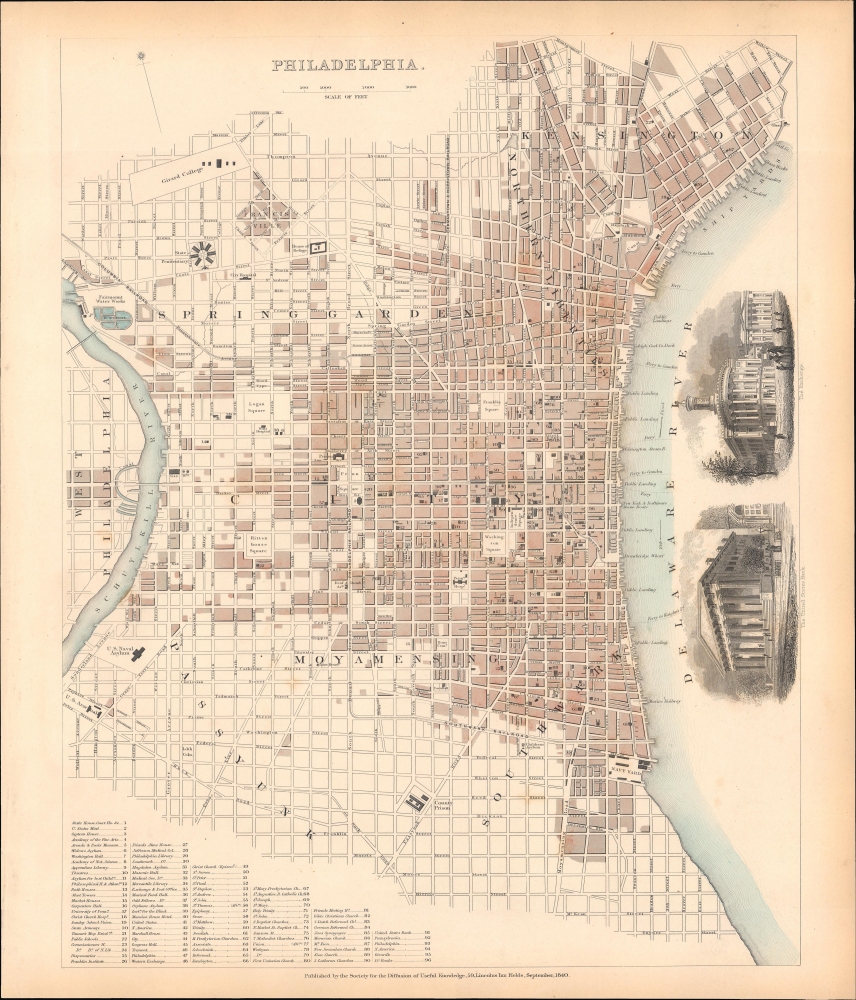This item has been sold, but you can get on the Waitlist to be notified if another example becomes available, or purchase a digital scan.
1840 S.D.U.K. Map of Philadelphia, Pennsylvania
Philadelphia-sduk-1840-2
Title
1840 (dated) 14.75 x 11.75 in (37.465 x 29.845 cm) 1 : 18000
Description
A Closer Look
The map depicts the entire city in stupendous detail, noting individual streets, important buildings, rivers, squares, piers, and neighborhoods. A key in the lower left quadrant lists the nearly one hundred locations numbered on the map. Two illustrations, one of the United States Bank (later known as the Custom House) and another of the Merchants' Exchange Building, are included along the right border.Noticeable towards top-left is the wheel-shaped Eastern State Penitentiary, one of the city's most distinctive structures. The penitentiary was arguably the first modern prison built in the United States, which, among other novelties, separated prisoners into individual cells (in effect, solitary confinement), which, it was thought, would increase the chances of rehabilitation. The 'Pennsylvania System' became influential throughout the country and throughout the world in the following decades.
Other features are notable for deviating from the grid-like street layout of the city, including Girard College and the Francisville neighborhood, built before the city instituted a uniform street grid.
Publication History and Census
This map was published by the Society for the Diffusion of Useful Knowledge in 1840. The physical map is listed among the holdings of roughly ten institutions in the OCLC and is also among the holdings of the David Rumsey Historical Map Collection.Cartographer
The "Society for the Diffusion of Useful Knowledge" (1826 - 1848) was a Whiggish organization founded in 1828 at the instigation of idealistic British lord Henry Peter Brougham. The admirable goal of the Society was to distribute useful information via a series of publications to the English working and middle classes. It promoted self-education and the egalitarian sharing of all knowledge. While closely tied to the London University and publishing houses on the order of Baldwin and Cradock, Chapman and Hall, and Charles Knight, the Society failed to achieve its many lofty goals in finally closed its doors in 1848. Most likely the failure of the Society resulted from its publications being too expensive for its intended lower to middle class markets and yet not large and fine enough to appeal to the aristocratic market. Nonetheless, it did manage to publish several extraordinary atlases of impressive detail and sophistication. Their most prominent atlas consisted of some 200 separately issued maps initially published by Baldwin and Cradock and sold by subscription from 1829 to 1844. Afterwards, the Society combined the maps into a single world atlas published under the Chapman and Hall imprint. In its day, this atlas was unprecedented in its quality, scope, and cost effectiveness. Today Society, or S.D.U.K. as it is commonly known, maps are among the most impressive examples of mid-19th century English mass market cartographic publishing available. The S.D.U.K. is especially known for its beautiful and accurately detailed city plans. More by this mapmaker...

